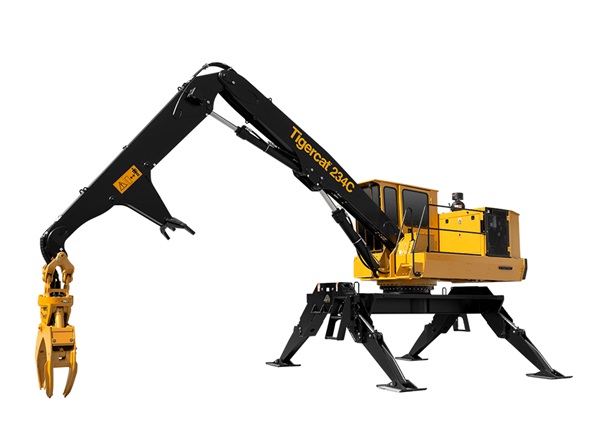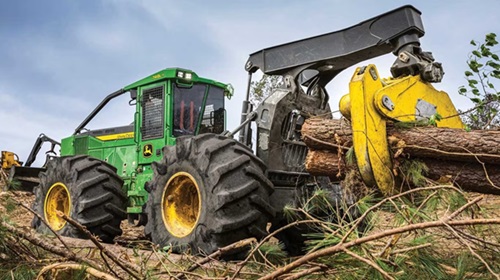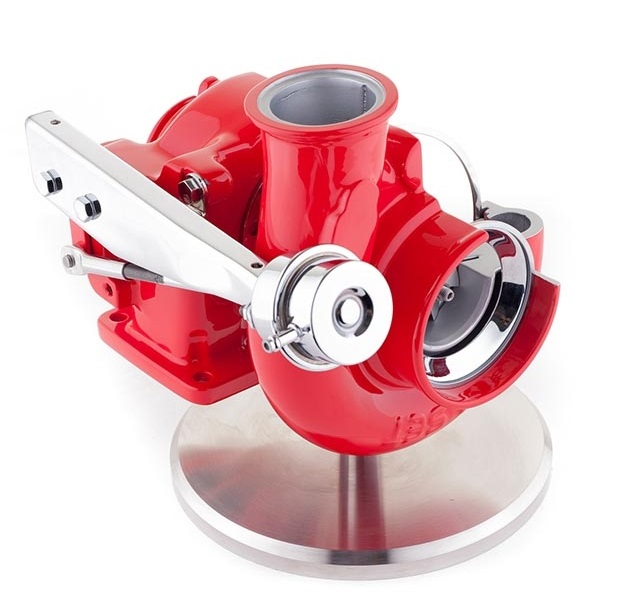
Tigercat introduces the 234C knuckleboom loader with operator enhancements and performance improvements.
Tigercat's long standing 234 series knuckleboom loader has been upgraded. The new 234C has a new boom system, a new cab, an improved hydraulic system and more swing torque. The new 234C boom system provides increased lift capacity, and quicker boom speeds. The boom cylinders are cushioned at the end of stroke for smoother boom operation. Through-tip hose routing is another new feature. Hydraulic hoses to the grapple are now routed through the boom tip for increased hose protection.
The Tigercat loader engineering team had the operator in mind when designing the 234C. The new operator’s station is more comfortable with 16% greater internal volume, increased width, and more leg room. Joysticks and switches are mounted on the armrests within comfortable reach. Improved A/C and heater controls allows the operator to set the desired temperature for a more comfortable working environment. Climate controlled cupholders keep drinks hot or cold for longer. Dedicated in-cabin storage areas include a space for a full size Tigercat insulated lunchbox.
Operator visibility has been improved with larger front and side windows. The wiper motor, radio and touchscreen display control system have all been relocated for improved sightlines. In addition, a redesigned swing motor cover further improves the operator’s line of sight to the work area.
Hydraulic system improvements include a new, larger main pump, and a new boom valve providing smoother boom control and improved flow sharing. Finally, swing torque has been increased by 13% over the 234B for improved pull-through delimbing performance. Source

The new John Deere Auto Pickup feature simplifies collecting skidder production data while keeping jobsite progress up to date in live time.
Without using Auto Pickup, operators must manually interact with the display to show the production completed on the job. This time-saving feature simplifies the collection of operational information. Helping to simplify collection, Auto Pickup can be activated at the beginning of a shift by simply tapping an icon on the TimberMatic Maps display. Once engaged, the Auto Pickup feature stays on between key cycles unless manually disengaged. Therefore, the operator does not need to focus on frequently turning the feature back on, keeping the operator concentrated on the job.
Once activated, the operator simply selects the appropriate landing where loads need to be placed, and using machine intelligence, Auto Pickup will continually monitor machine functions to determine if a bunch is properly being picked up. As the operator picks up a bunch, Auto Pickup will automatically select it, and after an adjustable, preset amount of time, the bunch is added to the chosen landing. This new feature helps simplify the collection process, and is ultimately a hands-free method, requiring less engagement from the operator.
While using Auto Pickup, skidder operators no longer need to pause and track their production. This helps confirm that production information and inventory moved to the loader is up to date in live time, instead of calculated hours after collection. As the job progresses, production data and logging routes are updated in real-time on TimberMatic Maps, displaying the actual status of the jobsite, helping to minimize guesswork. While Auto Pick data is being collected, owners, supervisors and foremen can monitor live progress remotely using TimberManager. This provides full visibility of a jobsite from any remote location, minimizing the need to be present on the logging site to monitor operations. Auto Pickup is now available on existing machines where TimberMatic Maps is installed. Source

Turbochargers for natural gas engines have evolved significantly, driven by stringent emissions regulations and the adoption of stoichiometric burning.
Modern natural gas turbochargers feature distinct components compared to their diesel counterparts. A decade ago, turbochargers for natural gas and diesel engines were not very different. However, new emissions regulations have driven the development of turbochargers specifically designed for natural gas engines. These turbochargers are adapted to stoichiometric burn conditions, where the mix of oxygen and fuel is precisely balanced. This balance ensures efficient combustion, leaving no unburnt fuel or excess oxygen.
Turbochargers developed for modern natural gas engines, have unique components like a dual wastegate port, larger actuators and a material housing made of composite materials that can withstand the higher temperatures a stoichiometric burn requires.
Turbochargers for natural gas engines are distinct from those used in diesel engines due to the unique demands of natural gas combustion like higher operating temperatures and distinct air-to-fuel ratios. Unlike diesel engines, which operate with a lean burn and a higher air-to-fuel ratio, natural gas engines require a stoichiometric burn. This means the mixture of oxygen and fuel is balanced precisely (1:1 air-to-fuel ratio) for efficient combustion, ensuring no unburnt fuel or excess oxygen remains. Consequently, natural gas engines require smaller turbochargers since less air is needed for stoichiometric combustion compared to the leaner burn in diesel engines. For example, a diesel engine might need an HE500 turbo, but a natural gas engine could use an HE300 or HE400 due to its lower air requirements.
Achieving this efficient combustion has led to significant modifications in many system components, including the incorporation of a dual wastegate port to handle the high bypass capability necessary for natural gas turbochargers. This port regulates exhaust flow, controls pressure and prevents over-boost.
The intense temperatures and pressures of natural gas engines also influence turbocharger design. While diesel engines prioritize turbocharger efficiency, natural gas engines focus on achieving the required mass flow rate and meeting exhaust gas recirculation (EGR) demands. As a result, turbochargers for natural gas engines are built with high-temperature materials, particularly at the turbine stage, to resist thermal fatigue.
These turbochargers also require water-cooled bearing housings to manage the elevated temperatures, necessitating additional piping and connections to maintain coolant flow.
While natural gas engines share many components with their diesel counterparts, key modifications have been made to turbochargers to accommodate the use of gaseous fuel. These changes address the higher temperatures and different flow characteristics unique to natural gas, ensuring optimal performance and durability.
A decade ago, natural gas and diesel turbos were nearly identical, but stringent emissions regulations like Euro 6 and EPA standards have driven significant changes, including the shift to stoichiometric burning, which increased operating temperatures and created the need for new turbocharger configurations.
By shifting to stoichiometric burning, Cummins was able to reduce the need for aftertreatment systems like Diesel Oxidation Catalysts (DOCs) or Selective Catalytic Reduction (SCR) systems, which ultimately lowered the cost of the engines and turbos. Source

Conducted at full operating speed of up to 65 mph (105 km/h), the product acceptance test underscores Torc's progress
The autonomous-ready Freightliner Cascadia with redundant safety features is an industry-first and lays the foundation for autonomous driving. Achieving driver-out capability on a closed course is a significant team achievement of the Torc and Daimler Truck teams. It demonstrates the progress and integrated development toward making autonomous trucking at scale a reality.
Conducted at full operating speed of up to 65 mph, the product acceptance test underscores Torc's progress in autonomous driving capabilities and prepares the company to be able to scale and commercialize safe, robust autonomous trucking solutions by 2027. Unlike a demo, this milestone highlights Torc’s entry into scalable product release, with their applied artificial intelligence technology, system architecture, production-intent embedded hardware, and safety engineering converging to shape a product that prioritizes true software best practices and safer roadways for all.
This product validation milestone exemplifies the commitment to rigorous safety and maturity standards, marking a critical step from advanced engineering and development to full productization on a unified, embedded platform.
Achieving the ability to run a truck without a safety driver in the cab is a significant milestone in the commercialization of autonomous driving. So far, Daimler Truck and Torc have tested and developed autonomous driving with a safety driver and an operator on board. Their task is to constantly monitor the truck during all operations and be ready to take over from the autonomous driver at any time. Daimler Truck and Torc have proven that Torc’s autonomous driving software can safely navigate on highways, surface streets, ramps and turns at controlled intersections. Source
Hiab is transforming the industry with the launch of its new autonomous load handling capabilities.
The introduction of these advanced driver assistance features aims to simplify the process of loading and unloading containers and cargo bodies, which typically require significant skill and precision. By automating complex manoeuvres such as reversing and positioning, Hiab is offering a solution that reduces the risk of errors and accidents while increasing overall operational efficiency.
The Driver Support feature automatically reverses the truck into position, aligning it with the front of the container for pickup. The driver initiates the process with the push of a button and monitors the safety of the intended operation via the augmented view on in-cabin screen. The feature utilises the truck’s off-the-shelf motion control interface.
Hiab’s new L2 Driver Support feature automates one of the most difficult aspects of load handling - reversing the vehicle into the optimal position for loading or unloading. The L2 Driver Support feature is equipped with robust safety protocols, adhering to international standards like ISO 26262 and aligning with the EU’s General Safety Regulation. This ensures that the technology is not only efficient but also meets the highest safety requirements for road operations. By reducing the need for manual precision and eliminating common errors, Hiab’s solution helps safeguard both the driver and surrounding assets from potential damage during complex load-handling tasks.
Hiab is a leader in automation solutions in the truck equipment industry. As early as 2019, Hiab launched HiVision for MULTILIFT hooklifts that can detect containers for guidance to reversing and lifting. In addition, Hiab designed and implemented the steering system for a self-driving truck in 2020. Hiab’s new L2 Driver Support technology is laying the foundation for further advancements in autonomous load handling. As the industry continues to evolve, Hiab remains at the forefront of innovation, developing solutions that complement the autonomous vehicle technologies emerging from leading truck Original Equipment Manufacturers (OEMs). Source
Read MoreNew Product Support Appointment for Tigercat in Brazil
In its ongoing efforts to provide first class after sale support and technical expertise, Tigercat has added its fourth member, Eberson Batista dos Santos, to the product support team in Brazil. Based in Curitiba, Parana state, Eberson assumes the role of factory support representative for South America. Eberson will work closely with Tigercat dealer Tracbel to provide after sale technical and operational support for Tigercat's growing line of forestry, off road, and material processing equipment. Source
Ponsse’s 3rd quarter results show a normal level of order flow activity
However, the order book is spread over a longer period and there are clear signs that the market is calming down. Customers' working conditions are reasonably good around the world, but investment activity has declined. The same situation can be observed in the demand for used machines. The weakening market situation is reflected in a reduction in the order book and order flow, which means that the Ponsse factory will have to adjust to the demand situation during the rest of the year. The operational performance of the factory is excellent and the availability of parts is generally good. Source
JCB has marked a major milestone with the production of its one millionth engine
Production started in 2004 at JCB Power Systems in Foston, Derbyshire, and expanded to JCB India in 2010 with the opening of a dedicated plant in Ballabgarh, Delhi. From three engines a day 20 years ago, JCB now produces around 500 a day, becoming a world leader in the design, development and manufacture of diesel engines and is now pioneering development of hydrogen combustion engines. Source
Read MoreTo see the full list of international logging, roading and trucking conferences and expo’s, please click the “Events” tab at the top of the page.
Read More